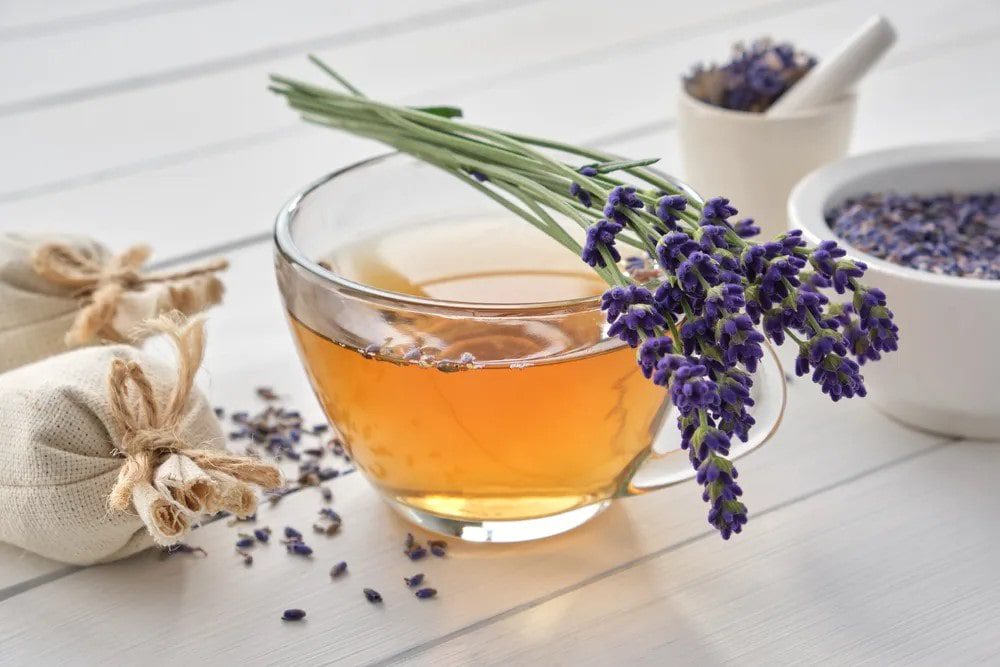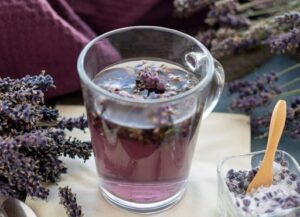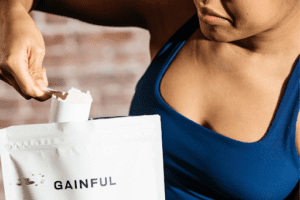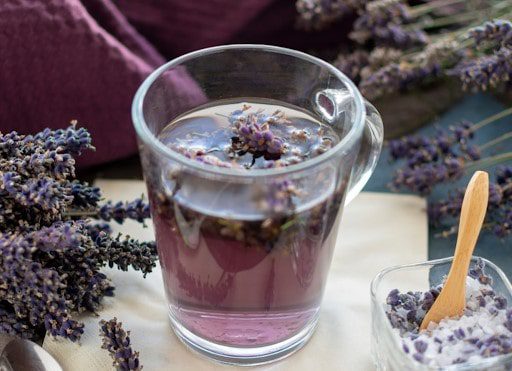Lavender is a beautiful addition to your tea repertoire, and it’s not only for smell and beauty. Lavender tea has been treasured for generations due to its possible health benefits and calming scent. Lavender tea offers a special balance of well-being and relaxation, whether you’re looking for a calming beverage for bed or want to try some new flavors. Let’s explore the world of lavender tea, including its uses, preparation methods, and many other aspects.
Lavender Tea: Benefits, Recipes, and More
In addition to being fragrant, lavender tea, a calming herbal infusion prepared from dried lavender flowers, has numerous possible health advantages. This mild tea’s relaxing properties and flexibility have made it beloved for generations, aiding with everything from digestion to relaxation. We’ll go over all you need to know about lavender tea in this extensive guide, including its history, health benefits, and the best way to brew it at home.
What is Lavender Tea?
The dried buds of the lavender plant, scientifically known as Lavandula angustifolia, are used to make lavender tea. Herbal tea connoisseurs frequently choose this aromatic herb, which is native to the Mediterranean region and has long been valued for its relaxing qualities.
Benefits of Lavender Tea
- Encourages Relaxation: Lavender tea is well known for its relaxing properties, which aid in lowering tension and anxiety levels. Lavender is a great option before bed because of its calming aroma, which can help to relax the body and mind.
- Aids Digestion: The chemicals linalool and linalyl acetate, which are present in lavender, may be able to alleviate digestive problems like indigestion and bloating. After a meal, a cup of lavender tea can help with digestion and ease discomfort.
- Promotes Better Sleep: Lavender tea is frequently suggested as a natural treatment for insomnia and enhances the quality of sleep because of its relaxing qualities. A cup of lavender tea before bed can aid in bodily relaxation and help set the stage for a good night’s sleep.
- Antioxidant Properties: The antioxidants in lavender can help fend off oxidative stress and shield cells from harm. Regular lavender tea drinking may improve general health and well-being.
- Benefits for the Skin: Applying lavender tea topically or utilizing products infused with lavender oil can help relieve skin irritations such as small burns, insect bites, and acne. Lavender is a common ingredient in skincare products because of its anti-inflammatory and antibacterial qualities.
How to Make Lavender Tea

Using dried lavender buds or store-bought lavender tea bags, making lavender tea is an easy task. Here is a simple recipe to get you going:
Components:
- One teaspoon of dried lavender buds, or one bag of lavender tea
- One cup of water that is boiling
Guidelines:
- Bring a saucepan or kettle to a boil.
- Put a tea bag or some dried lavender buds in a cup.
- Cover the lavender with a boiling water bath.
- Steep for five to ten minutes, depending on the strength you want.
- Remove the tea bag or strain the tea, discarding the lavender buds.
- Optionally, sweeten with honey or sugar to taste.
Read Also: How Lavender Chamomile Tea Promotes Relaxation
How to Incorporate Lavender Tea into Your Daily Routine
Adding lavender tea to your daily routine can improve your general well-being and provide you with moments of calm during the day. Here’s a thorough how-to for incorporating lavender tea into your regular activities:
Morning
- Calmly Start Your Day: Have a cup of lavender tea instead of your typical morning tea or coffee. Its mild flavor and calming aroma might help you calmly start the day.
- Intentional Morning Routine: Carefully prepare lavender tea. Enjoy the process of making and drinking your tea for a few seconds. This might help you calmly begin your daily routine.
Midday
- Afternoon Tea: Sip on a cup of lavender tea as you unwind in the afternoon. This might offer a welcome break from work or other everyday responsibilities and a peaceful moment during a hectic day.
- Stress Relief: Tea made with lavender flowers is a great way to relieve tension. Its relaxing qualities can aid in reducing stress and fostering mental clarity when things are busy.
Evening
- Evening Wind-Down: Make lavender tea a part of your evening relaxation ritual. Having a warm cup of tea before bed tells your body it’s time to unwind and get ready for sleep.
- Sleep Aid: Include a cup of lavender tea in your nightly routine. Its organic soothing properties might enhance the quality of sleep and encourage a deeper, more peaceful slumber.
Throughout the Day
- Hydration Alternative: Throughout the day, swap out sugary beverages for lavender tea. Drinking it hot or cold, it’s a refreshing and hydrating beverage choice.
- Digestive Support: To help with digestion, sip lavender tea after meals. After eating, its calming qualities may help reduce bloating and discomfort.
Additional Tips
- Try New Recipes: Discover several ways to savor lavender tea, like adding it to smoothies and lemonades or even cooking with it to provide a distinct flavor.
- Practice Mindful Consumption: Concentrate on the sensory aspects of drinking lavender tea as you engage in mindful consumption. Take note of its flavor, scent, and emotional impact.
- Regular Incorporation: Schedule certain times to sip lavender tea, including before bedtime or during breaks, to make it a regular part of your daily routine.
Read Also: Why Oatstraw Tea is Great for Your Health
Using Lavender Tea in Cooking and Baking

In addition to being a calming beverage, lavender tea may add its distinct flavor and aroma to a variety of culinary dishes. Here’s how to give a lovely twist to your dishes by including lavender tea in your baking and cooking endeavors:
Infusing Flavors
- Lavender-Infused Syrups: To make infused syrups, brew lavender tea. These add a lovely flowery flavor to mocktails and cocktails, or they can be drizzled over pancakes and waffles.
- Dressings and Marinades: Add brewed lavender tea to tofu, poultry, or meat marinades. It enhances savory foods with a delicate floral fragrance. Use it similarly to create a distinct flavor character in salad dressings.
Baking with Lavender Tea
- Lavender Tea Cakes: Use brewed lavender tea in place of part of the liquid in cake recipes. This gives cakes, like lemon lavender tea cakes or lavender Earl Grey cupcakes, a subtle flowery fragrance.
- Lavender Shortbread Cookies: To create lavender shortbread cookies, infuse butter with dried lavender buds or brewed lavender tea. Shortbread’s creamy buttery flavor goes well with the flowery scent.
Savory Dishes
- Lavender Tea Reductions: To add a gourmet touch to grilled fish or roasted vegetables, reduce lavender tea until it reaches a syrupy consistency.
- Lavender Tea Risotto: Incorporate brewed lavender tea into the risotto’s cooking liquid. The flowery undertones give the risotto depth and balance its creamy texture.
Tips for Cooking with Lavender Tea

- Quantity and Quality: To guarantee a pleasing flavor, use premium lavender tea. Due to its potency, starts with small amounts and adapts to taste.
- Balance Flavors: Think about how the floral tones of lavender will work with the other components in your recipe. To make sure the lavender complements the meal rather than overpowers it, balance is essential.
- Try new things: Don’t be scared to try out different recipes with lavender tea. There are lots of ways to use this adaptable ingredient in your recipes, whether they are savory or sweet.
Read Also:
Health Benefits of Drinking Hawthorn Berry Tea
How to Find the Perfect Coffee and Coffee Makers
Conclusion
Lavender tea is not only a drink but also a home medicine with a lovely flavor profile, potential health advantages, and a calming effect. Its adaptability makes it a perfect addition to your daily routine, whether you prefer it hot or cold. Lavender tea has a multitude of benefits for sleep and digestion, which is why it is so popular among tea drinkers across the globe. Accept the peace and goodness of lavender tea to have a more contented and healthful life.
FAQ’s
Can I bake and cook with any kind of lavender tea?
Although you can technically use any kind of lavender tea, it’s recommended to use organic or culinary-grade lavender meant for ingestion. This guarantees that there are no chemicals or pesticides in all the herbal teas that could change the taste of your food.
How can I add lavender tea to sauces and syrups?
Make a strong infusion of lavender tea and allow it to cool before adding it to syrups and sauces. Combine this concentrated tea with sugar and simmer until it thickens, to use it as a base for syrups. When making sauces, directly add the brewed tea to the cooking liquid and decrease it until the desired consistency and flavor are achieved.
What are some baking recipes that incorporate lavender tea?
When baking with lavender tea, begin by using brewed lavender tea in place of some of the liquid in your recipe. This allows the flavors of the flowers to seep into the baked goods without taking over. Make sure the lavender tea is prepared to the right strength so that the other ingredients in your recipe complement its aromatic features.
Can I use savory meals with lavender tea?
Indeed, lavender tea may give savory foods a distinctive depth of flavor. For a well-rounded flavor profile, combine its flowery overtones with herbs and spices to create marinades for meats or tofu. In a similar vein, add brewed lavender tea to the cooking liquid for risotto or use it as a last-minute flavor enhancer for roasted veggies.







